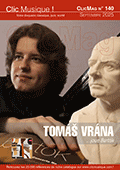|
|
|
Format : 1 CD
Durée totale : 00:49:32
Enregistrement : 01/06/2011
Lieu : Rome
Pays : Italie
Prise de son : Stereo
Label : Tactus
Référence : TC820002
EAN : 8007194105568
Code Prix : DM021A
Année d'édition : 2014
Date de sortie : 13/10/2014
Genre : Classique
|
|
 |
Pietro Morlacchi (1828-1868)Gran fantasia sopra alcuni motivi dell'opera Mosè in Egitto di Rossini, op. 3 Antonio Torriani (1829-1911)Duetto sopra pensieri dell'Opera Guglielmo Tell Composto Pietro Morlacchi (1828-1868)Divertimento sopra motivi dell'opera Lucia di Lammermoor di Donizetti Antonio Torriani (1829-1911)Duetto concertato per Flauto e Fagotto con accompto di Pianoforte sopra motivi del M° Verdi Trio Hormus
Carlo Tamponi, flûte
Francesco Bossone, basson
Stefano Micheletti, piano
|
 
 The great opera-music fantasias (such as the flute one by Morlacchi on Mosè in Egitto and the bassoon one by Torriani on Lucia di Lammermoor) actually were the mainstay of the publishing activity of Francesco Lucca and Tito and Giulio Ricordi in Milan. Non-professional lovers of music ranged, in their mastery of the instruments, from amateurs to concert performers. So the instrumental fantasias were “moulded” to the patrons’ specific requirements, and nourished a constantly growing market. When, at the end of the nineteenth century, Lucca’s daughters sold their father’s plates to the Ricordi publishing house, the sum paid by Ricordi for this commercial assimilation was huge for that period: this shows that the market of amateur instrumentalists had become enormous. So the history of Pietro Morlacchi and Antonio Torriani coincides with the history of the success of the instrumental music genre in Italy. Thanks to the quality and liveliness of their virtuosic style, these two composers’ pieces are still quite enjoyable in a concert performance. In Italy the composers who reduced operas were almost always instrumentalists, and their patient musical craftsmanship did not separate instrumental mastery from the invention of bravura variations: in other words, composition and virtuosity coexisted and were the backbone of these works. In the catalogues of the nineteenth-century publishers, the only pieces that survived were those that were really significant from a musical point of view: the works by Morlacchi and Torriani belong to this happy minority.
 |
| . |
 |
|
|
